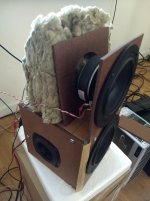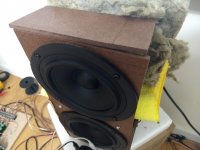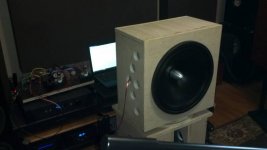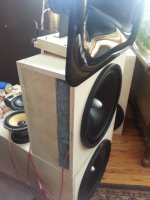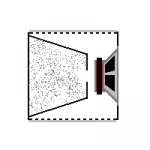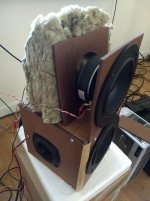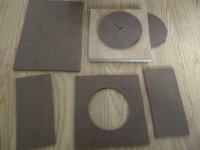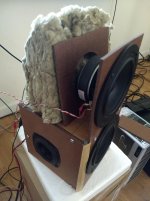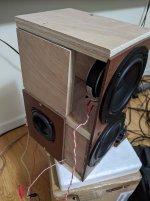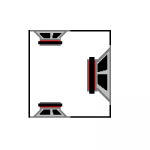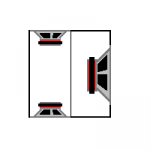Dutch and Dutch achieve a 20dB drop from front to side in their 8Cs. I built a low-mid cardioid but can only get a 8dB drop over the 200Hz to 1,200Hz spectrum. It is passive cardioid without active bandwidth cancelling.
What would you consider a successful drop in dB at 90 degrees off-axis over the 200-1,200 bandwidth using strictly passive methods?
I don't know if I can keep gaining more with passive or if I should just be happy and start working on active cancelling.
What would you consider a successful drop in dB at 90 degrees off-axis over the 200-1,200 bandwidth using strictly passive methods?
I don't know if I can keep gaining more with passive or if I should just be happy and start working on active cancelling.
I'm using the top driver in the photograph. Different configurations to see what works (e.g. placing a flat cap on top vs no cap on top.) In this case, the rockwool is primarily responsible for creating the cardioid radiation pattern. The top flat hardboard on top of the driver improves the cardioid by increasing dB level to the front around 1 to 2 dB.
Attachments
Have you thought of using your configuration as a dipole/monopole based cardioid? Just placing some wool behind a driver is not sufficient to turn a dipole onto a cardioid pattern, especially wideband. D&D use a specially tuned rear enclosure with strategically place slots to achieve the wideband cardioid effect.
Yes. I think I'll rebuild it as a dipole/monopole. I originally built the box so I could flip back and forth between active and passive (turning off the top or bottom). But I should have separated the active portion from the bottom enclosure so I could try dipole/monopole.
I didn't know D&D used a separate rear enclosure. Thanks for telling me how they did it. I might try that later.
I didn't know D&D used a separate rear enclosure. Thanks for telling me how they did it. I might try that later.
The trick with the dipole/monopole cardioid is apply EQ so they both have the same output over the overlapping frequency range. I think 200Hz is a reasonable target for the size of drivers you are using. You may still need to use some passive absorption, the rear output of most cone drivers is not the same as the front due to the obstructions.
Good eye. The CD is a BMS 4594.Face,
Is that an AE15m over an AE15s with a SEOS 24 horn? What CD are you using? How do you like the combination?
I like the combination, but I've since changed things up. Now the SEOS/BMS has two AE IB15 underneath in a solid Sapele open baffle frame. I still need to apply a finish...
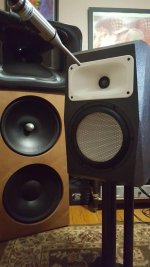
They integrated and measured well, I just prefer OB bass.So you prefer dipole over cardioid, or you were not able to get them to integrate?
You need a stuffed enclosure similar to below. View attachment 896805 View attachment 896806
Are those variable resistance enclosures or standard? And do you get a 20 dB drop from them? I was only able to get around 8, sometimes 10.
Attachments
Don't forget that the 20dB side cancelation was measured in a anechoic chamber. You are never going to measure that in a living room. 8 to 10dB in a living room is a pretty good achievement. Can you share the design?
Oh, I didn't realize that. That explains this video where someone measures their D&D outside. Dutch & Dutch 8C cardioid dispersion pattern - YouTube
I tried to copy what I saw in the D&D and the Kii Three in one speaker so I could switch back and forth to see which was easier to make. But I didn't design it very well so I'm going to rebuild it. Also, my measurements were sloppy because I didn't think I was accomplishing anything at only 8 to 10 dB. I thought I was way off the mark because I was looking for 20 dB.
I'm hesitant to mention something I experienced. I copied the D&D 8C flat plate behind the driver as you can see in the attached photo. It created what I would describe as an AM radio sound in the bandwidth of the driver (200-1,000Hz: a completely separate traditional driver not in the photo operates above 1,000Hz). However, the AM radio sound made wind instruments sound better. Jazz clarinet, for example. On the other hand, distorted rock music and complex orchestra did not sound good with the plate. Complex multi-instrument music sounded better when I removed the plate. I realize our mind plays tricks on us so that's why I'm hesitant to mention this.
Also, the rear plate seemed to be more cardioid while removing the plate seemed more super-cardioid. Without the plate I had a higher dB level at the rear, 180 degrees off axis.
Keep in mind, I don't know what I'm doing. I'm just copying what I've seen.
Attachments
Ah, that looks more like an open baffle rather than a cardioid enclosure.
When you add a backplate like that you get back reflection around 500 Hz or so, which causes the AM radio sound. To make it behave like a dipole more you should copy the complete mid enclosure of the D&D. that means a small closed box with slot on either side. The slots are located at the backend of the side panels. Next is damping and then EQ. But it still would be hard, if not undoable to extend the cardioid behaviour above 1kHz. So far for the theory. I never build one myself but was curious if someone else did and what kind of results there where.
When you add a backplate like that you get back reflection around 500 Hz or so, which causes the AM radio sound. To make it behave like a dipole more you should copy the complete mid enclosure of the D&D. that means a small closed box with slot on either side. The slots are located at the backend of the side panels. Next is damping and then EQ. But it still would be hard, if not undoable to extend the cardioid behaviour above 1kHz. So far for the theory. I never build one myself but was curious if someone else did and what kind of results there where.
It's open baffle in the photo but I wrap it with wood sections and tape. It's a learning platform so I wanted it to be adjustable. I add and remove pieces to see what happens. By doing that I was able to see how each section contributed to the radiation pattern.
On the bottom portion I use DSP to adjust time delay and amplitude. But it was a mistake to make it a shared enclosure. I would have had better control with separate containers. And I could have tried the previously suggested dipole/monopole cardioid in that case.
I was also surprised to find out that time delay actually mattered on the lower active portion of the speaker.
On the bottom portion I use DSP to adjust time delay and amplitude. But it was a mistake to make it a shared enclosure. I would have had better control with separate containers. And I could have tried the previously suggested dipole/monopole cardioid in that case.
I was also surprised to find out that time delay actually mattered on the lower active portion of the speaker.
Attachments
I built a second enclosure with a separated chamber for the noise cancelling drivers. The first model was a shared chamber.
The first version with the shared chamber worked with little effort. Separated chambers was a little more difficult to adjust.
I operated the separated chamber in dipole/monopole cardioid but it had problems below 400Hz because the dipole couldn't keep up with the enclosed monopole. Easy solution, turn on the noise cancelling side firing drivers below 400Hz.
The top portion of the second enclosure is removable. The back is also removable to create super-cardioid radiation. I also have removable slats I can use to decrease the side slot widths.
I'm not sure which passive cardioid design I prefer for the dipole driver. Open baffle, cardioid, and super-cardioid all seem to sound good in different ways. I'm going to need to build a duplicate so I can listen in stereo and make adjustments.
My biggest impression when turning on active noise cancelling below 400Hz is that it removes some of the muddiness. At present, I think it sounds best when the dipole (top) is 100Hz to 1,000Hz and the monopole (bottom) is 100Hz to 500Hz with the side noise cancelling also set from 100Hz to 500Hz. When I set the dipole to run 500Hz to 1,000Hz it is clear but not as enjoyable because it loses spaciousness. However, I've only listened in mono. I suspect setting the dipole 500Hz to 1,000Hz would sound better in stereo.
Turning off the dipole (top) and running just the enclosed monopole with active cancelling sounds good as well. Very clear but it does not sound as good as running both dipole and monopole. I don't know why I think that and it might just be that I like it because it sounds different. I'd describe it as more realistic sounding but that's a pretty useless explanation to tell other people, so I'll stick with saying I like the dipole/monopole combo better subjectively and leave it at that. My opinion might change over time and according to mood.
The first version with the shared chamber worked with little effort. Separated chambers was a little more difficult to adjust.
I operated the separated chamber in dipole/monopole cardioid but it had problems below 400Hz because the dipole couldn't keep up with the enclosed monopole. Easy solution, turn on the noise cancelling side firing drivers below 400Hz.
The top portion of the second enclosure is removable. The back is also removable to create super-cardioid radiation. I also have removable slats I can use to decrease the side slot widths.
I'm not sure which passive cardioid design I prefer for the dipole driver. Open baffle, cardioid, and super-cardioid all seem to sound good in different ways. I'm going to need to build a duplicate so I can listen in stereo and make adjustments.
My biggest impression when turning on active noise cancelling below 400Hz is that it removes some of the muddiness. At present, I think it sounds best when the dipole (top) is 100Hz to 1,000Hz and the monopole (bottom) is 100Hz to 500Hz with the side noise cancelling also set from 100Hz to 500Hz. When I set the dipole to run 500Hz to 1,000Hz it is clear but not as enjoyable because it loses spaciousness. However, I've only listened in mono. I suspect setting the dipole 500Hz to 1,000Hz would sound better in stereo.
Turning off the dipole (top) and running just the enclosed monopole with active cancelling sounds good as well. Very clear but it does not sound as good as running both dipole and monopole. I don't know why I think that and it might just be that I like it because it sounds different. I'd describe it as more realistic sounding but that's a pretty useless explanation to tell other people, so I'll stick with saying I like the dipole/monopole combo better subjectively and leave it at that. My opinion might change over time and according to mood.
Attachments
Last edited:
From Sound Reproduction 3rd edition, Floyd Toole, Chapter 7.4.2
So I'm going to start using that frequency as a rule of thumb for transition to mid-range cardioid if the speakers are located near walls. The biggest difference I perceived was clarity, less muddy.
I personally didn't notice as large of a difference when I actively noise cancelled above 500Hz. Which leads me to suspect passive cardioid dipole sounds subjectively better *to me personally* above 500Hz for reasons other than cardioid radiation. It might just be the open baffle sound some people like.
The curves are truncated below 500 Hz because at lower frequencies room modes and adjacent-boundary effects progressively dominate.
So I'm going to start using that frequency as a rule of thumb for transition to mid-range cardioid if the speakers are located near walls. The biggest difference I perceived was clarity, less muddy.
I personally didn't notice as large of a difference when I actively noise cancelled above 500Hz. Which leads me to suspect passive cardioid dipole sounds subjectively better *to me personally* above 500Hz for reasons other than cardioid radiation. It might just be the open baffle sound some people like.
Just read this on Sean Olive's blog. Audio Musings by Sean Olive: Audio's Circle of Confusion
Olive's observation in conjunction with Earl Geddes' statements on major frequency ranges ("we live above 1,000Hz") seems like additional justification to use ~1,000Hz as a frequency focus in design. As you cross below 1,000Hz consider using design to reduce room interaction.
I think this argues against loudspeaker design theories that advocate against crossing over between drivers in the "critical" vocal frequency range between low-mids and treble.
"The 1/3-octave smoothed curves show a reasonably tight ± 2.5 dB variation above 1 kHz. However, below 1 kHz, variation in the in-room response gets progressively much worse at lower frequencies. Below 100 Hz, the in-room bass response can vary as much 25 dB among the different control rooms! You needn’t look any further than here to understand why the quality and quantity of bass is so variable among the recordings in your music library." - Olive
Olive's observation in conjunction with Earl Geddes' statements on major frequency ranges ("we live above 1,000Hz") seems like additional justification to use ~1,000Hz as a frequency focus in design. As you cross below 1,000Hz consider using design to reduce room interaction.
I think this argues against loudspeaker design theories that advocate against crossing over between drivers in the "critical" vocal frequency range between low-mids and treble.
The idea of avoiding a region is based on the premise that a crossover will create problems...I think this argues against loudspeaker design theories that advocate against crossing over between drivers in the "critical" vocal frequency range between low-mids and treble.
- Status
- This old topic is closed. If you want to reopen this topic, contact a moderator using the "Report Post" button.
- Home
- Loudspeakers
- Multi-Way
- Low Mid Range Cardioid dB
